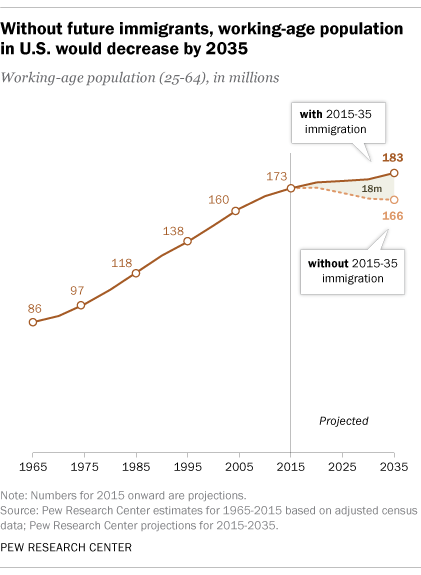The Trump administration is fixated on driving down immigration and on driving up economic growth. But there’s good reason to believe that if it succeeds at the first, it will almost certainly fail at the second by depriving the country of the labor force it desperately needs.
Data collected by the Pew Research Center demonstrates that over the next twenty years, among all people in the US in prime working age (25-64), Americans born in the US to parents who were also born in the US will be a smaller share of the workforce, not only in terms of percentage but in terms of absolute numbers.
Related: Can Trump’s Wall Really Pay for Itself Over 10 Years?
In 2015 there were 128.3 million US-born people in the labor force whose parents were also born in the US. By 2035, that number will have fallen to 120.1 million. They will still make up a majority of the workforce, but as the Baby Boom generation retires, they will make up a smaller percentage, falling from 74 percent in 2015 to 66 percent in 2035.
Over that same time period, Pew estimates, the number of current immigrants -- people physically present and in the workforce right now -- will decline by 17.6 million as some age, return to their home countries, or are pushed out of the labor force for other reasons.
The difference will be partly made up by US-born children of immigrants, currently aged seven or older, who will turn 25 by 2035. But as they join the workforce, they will only increase the labor supply by 13.5 million, not nearly enough to make up for the loss of more than 25 million US-born children of US-born parents and current immigrants.
The difference, if it is to be made up, will have to be made up by new immigrants -- people who have not yet come to the US, but who would arrive between now and 2035 unless current policies are changed.
Related: Trump Pushes Congress to the Wall to Avoid a Government Shutdown
Pew currently projects that the net number of immigrants in the workforce -- meaning those already here plus new arrivals -- will increase slightly between 2015 and 2035, from 33.9 million to 38.5 million. Those projections, according to the study, are “based on current rates of both lawful and illegal immigration. They assume that two-thirds of immigrants arriving through 2035 will be ages 25 to 64, as is true of today’s new immigrants.”
However, those numbers could change dramatically if the Trump administration is successful in curtailing immigration. And that could become a real economic problem.
As the percentage of Americans living in retirement, collecting Social Security checks and charging their health care costs to Medicare increase, a workforce that is increasing in size, not shrinking or remaining the same, is essential to keeping the economy growing. That’s because a growing economy is the surest way to guarantee that the government collects enough tax revenue to keep the Social Security checks coming and medical benefits available.
It’s well-established that immigration drives economic growth in the US. According to a report from the National Academies of Sciences, Engineering and Medicine, “immigration has an overall positive impact on long-run economic growth in the U.S.” even if new immigrants represent a temporary fiscal burden on states and municipalities. That fiscal burden costs taxpayers $279 billion annually.
Related: Trump’s Wall, By One Estimate, Could Cost $70 Billion
“In terms of fiscal impacts, first-generation immigrants are more costly to governments, mainly at the state and local levels, than are the native-born, in large part due to the costs of educating their children,” the report finds. “However, as adults, the children of immigrants (the second generation) are among the strongest economic and fiscal contributors in the U.S. population, contributing more in taxes than either their parents or the rest of the native-born population.”
If the country needs a constant flow of immigrants to replenish the labor force and contribute the payroll taxes that sustain the government’s largest entitlement programs, perhaps it’s lucky that there is evidence that Americans are becoming increasingly aware of the benefits of healthy net immigration.
A Wall Street Journal/NBC News poll released on Tuesday found a record high percentage of the population, 60 percent, believe that immigration is a net positive for the US, compared to 33 percent who believe it does more harm than good. The percentage of people who said they view immigration positively jumped six points from the last time the survey was taken, in September 2016.
It’s unclear how much changing public perceptions of immigration will impact the Trump administration’s goal of reducing immigration, given that being an immigration hardliner is one of the things about Trump that endears him to his base supporters.
But to the extent those supporters are also retiring Baby Boomers who want to keep their federal benefits flowing undiminished, they might want to take a second look at the administration’s plans.






